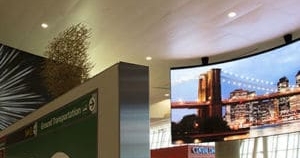Though an airport ultimately exists to help transport people from one place to another, in practice an airport performs a sprawling variety of functions. And while successful travel is certainly the primary factor in a passenger’s experience, there are countless other elements that contribute. Independent of flight delays or cancellations, travelers frequently cite crowded hallways, insufficient wayfinding directions, and difficult-to-locate flight information as their greatest pain points. Irritants like these obviously impact a traveler’s overall airport experience and according to research from J.D. Power & Associates, the mood of a traveler in an airport has a high degree of correlation with how much money he or she spends while there. How can an airport alleviate some of these issues? With airport digital signage solutions of course.
Diverse challenges require versatile solutions. Travel through several of the world’s top airports and you’ll find Nanolumens displays filling a wide variety of needs. Here’s a few of them:
FIDS – Flight Information Display Systems
Anyone who has travelled by plane knows that airports can be frustrating. The job of an airport staff is to minimize that frustration. LED displays help them do that by showcasing flight information in bigger and brighter ways. An example of this can be found in Atlanta’s Hartsfield-Jackson Airport. Where once there stood a dimly lit LCD display that prompted congregations to gather in a scrum to see the screen, now there shines a brilliant LED display bright enough for crowds to see their flight data from further distances and wider angles. The jostling bustle of FIDS viewers that used to crowd this thoroughfare is thus dispersed, and foot traffic flows more efficiently because of it.
RIDS – Ramp Information Display Systems
Barring extreme weather conditions, an airport is expected to operate rain or shine, and therefore, so are RIDS. These display technologies need to be durable enough to withstand intense heat and bitter cold. They need to be sturdy enough to hold up against heavy precipitation, and secure enough to keep out dust, dirt, or any other debris the wind might whip up. On top of this, RIDS need to be bright enough to compete with the sun. The only display technology that can meet these kind of performance standards is LED.
Wayfinding
Whether travelers are looking for dining options, shopping areas, restrooms, or other airport facilities, the directions they need are brighter, clearer, more flexible and more visible when displayed on LED signage. Vancouver International Airport came to this very conclusion when renovating their International Arrival Customs Terminal. Initial impressions matter immensely, and global travelers arriving to Canada, perhaps for the first time, are now met with the sleek, minimalist design of a 32-foot by 9-foot display welcoming them to Vancouver and providing them highly relevant information about how to proceed from their gate. This is how you refresh the passenger experience; present information travelers need in a big, beautiful way, and let them be on their way.
Non-Aeronautical Revenue
Displaying several different types of content on airport digital signage is an excellent way to take advantage of its versatility. By selling ad space on a display to eager retailers, an airport using their LED solution chiefly for other purposes will accomplish their primary goal while generating revenue as well. Even displays that feature wayfinding data, flight information, artwork, or other creative content can boost consumer spending elsewhere in the terminal. When once passengers were stranded passing the time only in view of their gate, the proliferation of LED display tech within the airport space allows travelers to more freely move about the terminal, since everywhere they go they’ll have immediate access to wayfinding directions and FIDS.
Art & Culture
Often the first thing a traveler sees when they arrive in a new city, airports serve an important role in communicating and celebrating the culture of the region they service. Travelers don’t just want to be somewhere, they want to feel somewhere. Consider “The Flower” found in Toronto’s Pearson Airport. The stunning airport digital signage feature dominates a central gathering area of Terminal 1 with its beauty while also serving the practical purpose of providing flight information and weather details to busy travelers. It has transformed what once was dead space into perhaps the most highly-trafficked location in the entire airport concourse, simultaneously branding the airport with the provincial symbol of the White Trillium flower.
Nanolumens is capable of designing and installing airport digital signage to resolve whatever your airport pain points may be. To explore our airport expertise further, check out our white paper on the topic here.

